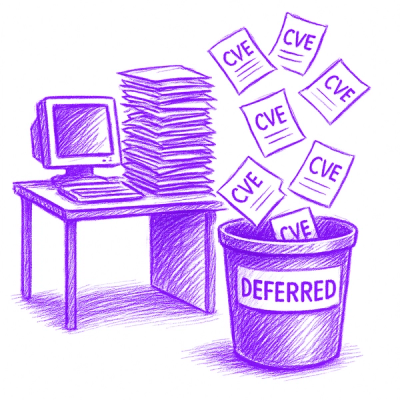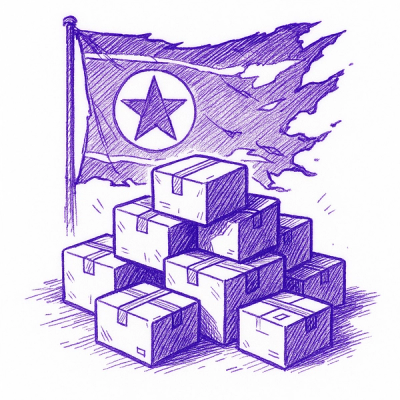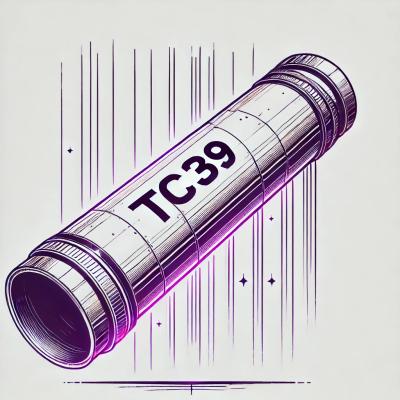
Security News
NVD Quietly Sweeps 100K+ CVEs Into a “Deferred” Black Hole
NVD now marks all pre-2018 CVEs as "Deferred," signaling it will no longer enrich older vulnerabilities, further eroding trust in its data.
Package to aid in the design of low-slope roof systems for ponding stability and impounded rain load.
pondpy is a package built to aid in the design of low-slope roof bays for ponding stability and impounded rain loading. It utilizes a series of purpose-built finite element and ponding analysis classes and methods to be as intuitive as possible for the modern engineer.
Install pondpy with pip:
pip install pondpy
The PondPyModel class is designed to work with several purpose-built classes
that help the user organize their input into a form that are readily utilized
to build and analyze the model. These are the PrimaryFraming,
SecondaryFraming, and Loading classes. In addition, the package is
designed to work with the steelpy and joistpy packages, though any
object containing the requiring information attribures (i.e. moment of inertia,
cross-sectional area, elastic modulus, etc.) could be used in lieu of either
package.
To create and analyze a roof bay model, first import the required dependencies and classes:
from joistpy import sji
from steelpy import aisc
from pondpy.analysis.fem_analysis import (
SteelBeamSize,
SteelJoistSize,
)
from pondpy.analysis.pond_analysis import (
PrimaryMember,
PrimaryFraming,
SecondaryMember,
SecondaryFraming,
Loading
)
from pondpy.pondpy import PondPyModel
Next, define the steel shapes and joist designations in your model.
w12x16 = SteelBeamSize('W12X16', aisc.W_shapes.W12X16)
w16x26 = SteelBeamSize('W16X26', aisc.W_shapes.W16X26)
k_14k1 = SteelJoistSize('14K1', sji.K_Series.K_14K1)
Next, define the primary and secondary framing in the roof bay framing system. Note that all inputs should be in kips and inches.
p_length = 20*12 # length of primary members in inches
s_length = 20*12 # length of secondary members in inches
# Support types are designated by tuples representing (Tx, Ty, Rz).
# A 0 indicates the degree of freedom is unrestrained while a 1 indicates a
# restrained degree of freedom.
p_support = [[0, (1, 1, 0)], [p_length, (1, 1, 0)]]
s_support = [[0, (1, 1, 0)], [s_length, (1, 1, 0)]]
p_girder1 = PrimaryMember(p_length, w16x26, p_support)
p_girder2 = PrimaryMember(p_length, w16x26, p_support)
s_beam1 = SecondaryMember(s_length, w12x16, s_support)
s_beam2 = SecondaryMember(s_length, w12x16, s_support)
s_joist1 = SecondaryMember(s_length, k_14k1, s_support)
s_joist2 = SecondaryMember(s_length, k_14k1, s_support)
s_joist3 = SecondaryMember(s_length, k_14k1, s_support)
p_framing = PrimaryFraming([p_girder1, p_girder2])
s_framing = SecondaryFraming([s_beam1, s_joist1, s_joist2, s_joist3, s_beam2])
Note that each member should be individually defined as shown above. Otherwise, the loadings will not be applied correctly to the members.
The roof slope can optionally be set in the SecondaryFraming object by
using the keyword slope and entering the roof slope in inches/foot. The
default value is 0.25.
Next, define the loading in the roof bay.
p_framing = PrimaryFraming([p_girder1, p_girder2])
s_framing = SecondaryFraming([s_beam1, s_joist1, s_joist2, s_joist3, s_beam2])
q_dl = 20/1000/144 # Surface dead load in ksi
q_rl = 22.4/1000/144 # Surface rain load at secondary drainage inlet in ksi
loading = Loading(q_dl, q_rl)
The input rain load should include the static head and the hydraulic head, but no ponding head.
Finally, define the PondPyModel object and analyze the model.
pondpy_model = PondPyModel(p_framing, s_framing, loading)
pondpy_model.perform_analysis()
Optional arguments for the PondPyModel include:
mirrored_left: bool indicating whether the roof bay is mirrored
on the left side; default is False
mirrored_right : bool indicating whether the roof bay is mirrored
on the right side; default is False
stop_criterion : float indicating the error in total impounded
water weight at which the iterative analysis should be terminated;
default is 0.0001
max_iter : int indicating the maximum number of iterations that
should be performed; default is 50
show_results : bool indicating whether the iteration results should
be printed to the terminal upon completion of the analysis;
default is True
Each primary and secondary member is represented within the PondPyModel object by a BeamModel object. As such a great deal of analysis results can be obtained fairly easily once the analysis is complete.
To access the deflected shape, shear force diagram, or bending moment diagram of a particular member, use the following calls:
member = pondpy_model.roof_bay_model.secondary_members[0]
bmd = member.plot_bmd()
bmd.show()
The shear force diagram and deflected shape can be accessed in a similar
fashion using the plot_sfd() and plot_deflected_shape() methods.
The deflected shape, shear force diagram, and bending moment diagram plots
for all members can all be generated by using the RoofBayModel's
generate_plots() method.
plots = pondpy_model.roof_bay_model.generate_plots()
This method returns a dict object with keys bmd, sfd, and
defl, each of which is associated with a sub-dictionary with keys
Primary and Secondary. Each sub-dictionary contains a list of
the associated plot for each primary or secondary member, as applicable.
The support reactions can be obtained as follows:
support_nodes = member.support_nodes
support_reactions = [member.support_reactions[node] for node in support_nodes]
Several other attributes of the BeamModel object can be accessed in a similar fashion.
New: A report of the PondPyModel analysis results can now be generated by
calling the PondPyModel's generate_report() method.
Once an analysis has been performed, simply call the method:
output_folder = 'path/to/output/folder/'
pondpy_model.generate_report(output_folder)
Once complete, navigate to the folder you designated as the output folder and view the report.
See the example_reports directory in this repo for an example report created using the example in main.py.
Note that only the final analysis results can currently be accessed.
FAQs
Package to aid in the design of low-slope roof systems for ponding stability and impounded rain load.
We found that pondpy demonstrated a healthy version release cadence and project activity because the last version was released less than a year ago. It has 1 open source maintainer collaborating on the project.
Did you know?

Socket for GitHub automatically highlights issues in each pull request and monitors the health of all your open source dependencies. Discover the contents of your packages and block harmful activity before you install or update your dependencies.

Security News
NVD now marks all pre-2018 CVEs as "Deferred," signaling it will no longer enrich older vulnerabilities, further eroding trust in its data.

Research
Security News
Lazarus-linked threat actors expand their npm malware campaign with new RAT loaders, hex obfuscation, and over 5,600 downloads across 11 packages.

Security News
Safari 18.4 adds support for Iterator Helpers and two other TC39 JavaScript features, bringing full cross-browser coverage to key parts of the ECMAScript spec.